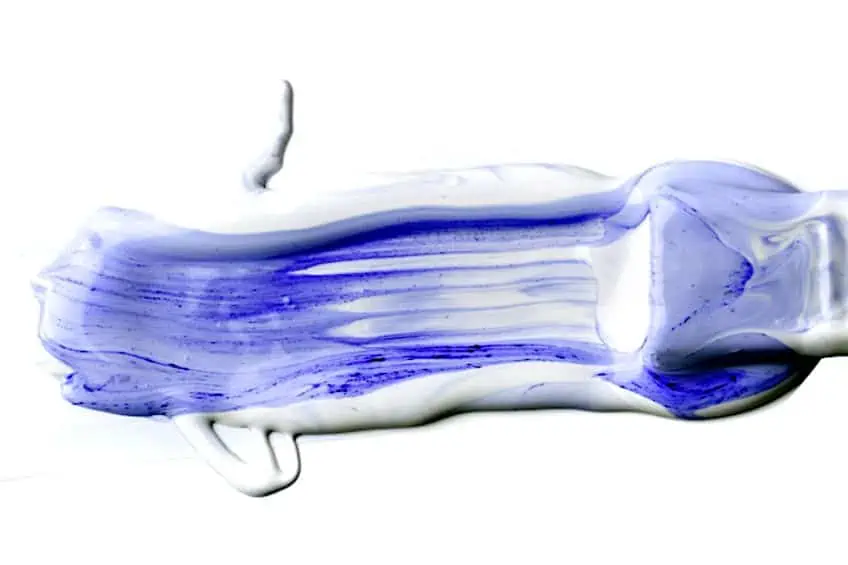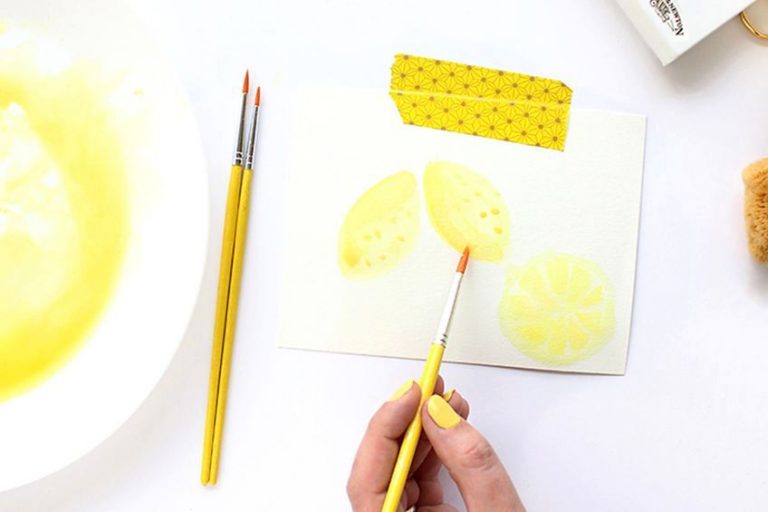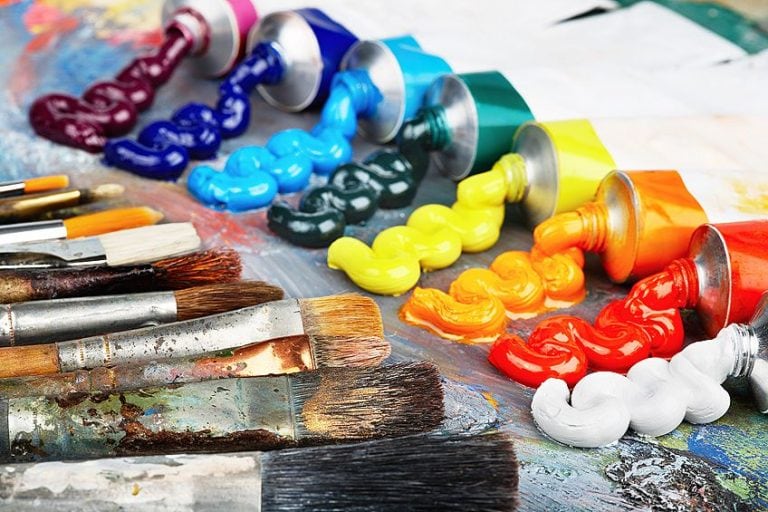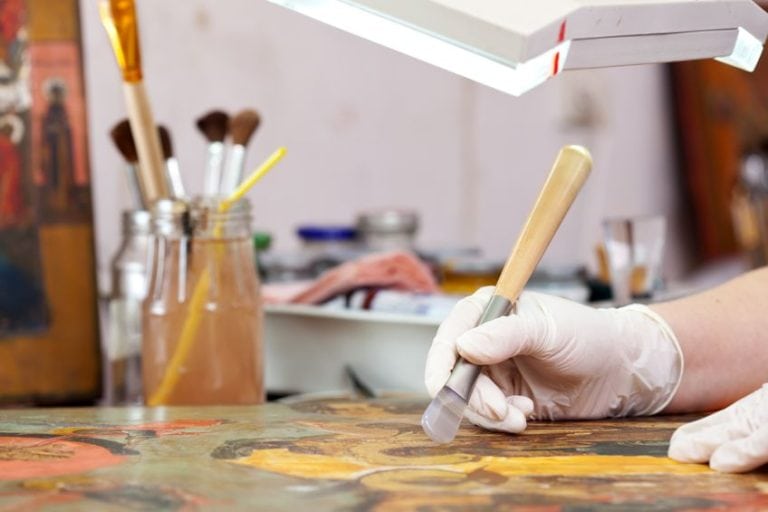How to Thicken Acrylic Paint – The Best Way to Create Textured Paint
This post may contain affiliate links. We may earn a small commission from purchases made through them, at no additional cost to you.
You have just organized all your equipment and supplies, and you are about to start with your painting, but as you load your paintbrush with your acrylic paint, you discover that the paint is rather thin. It does not matter how many layers of paint you apply to your painting; the result is a runny blotch of paint. Your first reaction is to throw out the paint, but before you do that, how about trying to make acrylic paint thicker? In this article, we will be showing you how to thicken acrylic paint and save some money in the process.
Table of Contents
A Brief Description of Acrylic Paint
If you are new to using acrylic paint, let us first explain what acrylic paint is. Acrylic paint is a quick-drying, water-soluble paint mixture that is composed of small pigment particles that are diffused in an acrylic polymer emulsion. This consists of three main components, the acrylic paint pigment, the binder, and the vehicle. The pigment in the paint is what provides color and consists of small pigment particles that are floating around in the paint. These paint pigments can be organic, synthetic, or inorganic, and should adhere to any surface they are applied to.

The binder also referred to as the acrylic polymer, has two main roles to play. First, to keep the pigment particles in place when the paint has set, and second, it forms a protective layer over the paint once the water has evaporated. The vehicle for acrylic paint is water and it carries the pigment and the binder. When the water combines with the binder, it forms the acrylic polymer emulsion, and when all the water in the paint has evaporated, the paint dries to form a stable and clear film with the colored paint pigments trapped inside.
What Makes Acrylic Paint So Special?
Acrylic paint is a very versatile paint and is used by artists, home renovators, school children, and students. The paint can be applied to a canvas, paper, walls, doors, cupboards, and a host of other surfaces. So, why do some artists prefer using acrylic paint?
- Acrylic paint can dry quickly in about 10 minutes, which makes it popular with many artists.
- The paint is very flexible, which makes it perfect for various applications on different surfaces.
- Acrylics are easy to clean, you only need to use water while it is still wet to remove it.
- Becomes permanent once dry, so you do not have to worry about it coming off.
- Comes in a range of consistencies or formulations from the light body to heavy body acrylics.

- Can adhere to almost any type of surface including plastic, wood, glass, canvass, and more.
- Acrylic paints can be used to accomplish a large number of techniques and styles.
- Has no odor or fumes and is also non-flammable, making it safe and easy to use.
- The properties of the paint can be altered by using various mediums, for example, making it thicker.
How to Thicken Acrylic Paint
Acrylic paint is quick-drying, versatile, and water-soluble, which makes it very popular amongst artists. However, many brands of acrylic paint are too thin, making it difficult to work with. This means they do not produce the right texture, causing many artists to complain about its viscosity. So, how to thicken acrylic paint?
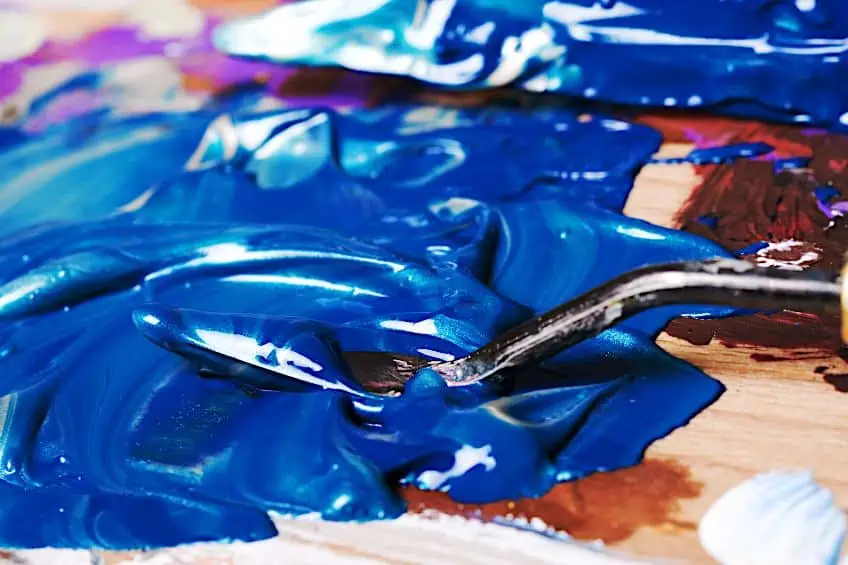
Paint mediums are products that you can use by adding them to your paint to make it thicker. You can also apply it directly onto your canvas or paper, which helps to build the texture as well as the appearance of the paint. By changing the texture of the paint and using different strokes or lines, you can create a form of movement in a two-dimensional painting. In other words, the thick textured paint can create a three-dimensional effect.
Not only can you achieve these types of results, but by thickening your acrylic paint, you can also enjoy the beauty of an oil painting without the weeks of drying time that an oil painting requires. The thickened acrylic paint can also change the surface finish of your painting, giving it a matte, transparent, or watercolor effect, depending on the brush strokes you apply.
Acrylic mediums can come in a pourable or moldable form, allowing you to alter your paint to your needs.
Two paint mediums are available, which are best to use to thicken your acrylic paint. These include your gels and paste mediums. But you need to make sure that the gel or paste you choose is compatible with acrylic paint, as some of the mediums are specially formulated for use with other types of paint. The correct gels or pastes for acrylic paint are made using the same resins and also the other ingredients that manufacturers use to make acrylic paint.
To make sure you buy the correct paint medium, read the label, which should clearly state that the gel or paste will dry opaque or clear and have a gloss or matt finish. The label should also indicate that it will not influence the color of your acrylic paint, as some products look white, but they will dry clear. Others contain filters that affect the intensity of the color of your paint.
Acrylic Gel Medium
An acrylic medium that comes in a gel is made from the same polymers as the paint. So, they will in no way affect the color, texture, longevity, or quality of the paint. This type of acrylic paint thickener comes in various viscosities as well as finishes, for example, gloss, semi-gloss, and matte. Remember that you are using a thickening gel for acrylic paint, so you need to choose a gel medium that is thicker than the acrylic paint you are using.
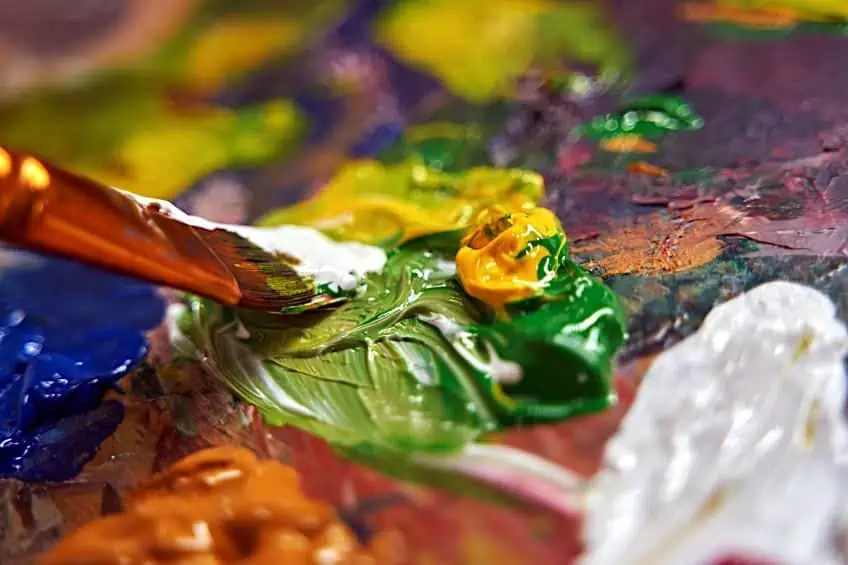
All you need to do is add a small amount of the gel medium to your paint, mix it properly with a palette knife, and keep on adding until you are satisfied with the texture you want. Then just spread it onto your canvas as you would do when adding frosting to a cake. You will notice that the gel medium is wine-red, but it will not affect the color of your acrylic paint as it dries clear. Besides it dries clear, it can also give you a variety of finishes, making it ideal for mixed-media and collage work.
Soft Acrylic Gel
The soft acrylic gel is slightly thinner than the regular gel and is not able to keep the brush bristle marks like the thicker gels or create thick impasto paintings. However, it is useful for creating any transparent glaze. A good product to purchase for this purpose is Golden Artist Colors’ Soft Gel Gloss. If you are painting with fluid acrylics, then this soft gel can be used to thicken the paint.
You will not, however, be able to create any brush strokes that keep the bristle marks or create sharp palette knife marks.
Regular Acrylic Gel
The regular acrylic gel has a similar consistency to the heavy body paint, so it will not make acrylic paint thicker; you need to use an extra heavy gel to make the heavy body paints thicker. A good product to purchase for this purpose is Golden Acrylic Medium’s Regular Gel Semi-Gloss. When you add the regular gel to the heavy body paint, you will find that it increases the transparency of the paints without losing the thickness. This type of gel will assist you in keeping sharp edges and high peaks that can be created with your palette knife.
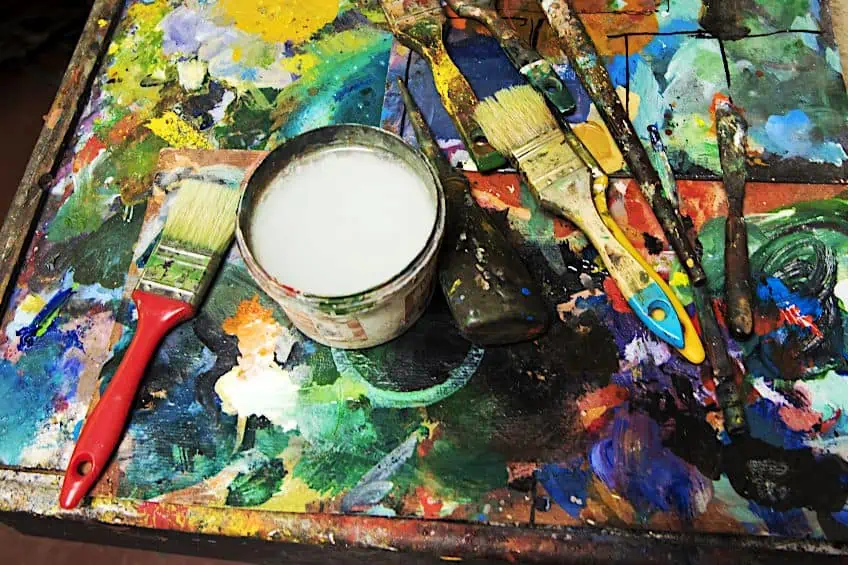
Heavy and Extra Heavy Acrylic Gel
The names of the heavy, extra heavy and super-heavy acrylic gels may vary from brand to brand, but they will all perform in the same way. A good product to purchase for this purpose is Liquitex’s Professional Gloss Heavy Gel Medium. They are thicker than all of the other gels. These types of acrylic gels appear to be thicker even than oil paints and can be applied to your canvas with putty or a palette knife.
This should produce all of those sharp edges and peaks.
Semi-Gloss Acrylic Gel
To achieve a semi-gloss effect, you will have to mix the matte gel with the gloss gel, which will then create a semi-gloss effect. A good product that is available on the market for this purpose is Golden Acrylic Medium’s Regular Gel Semi-Gloss. This mixture has the effect of removing the gloss as well as the matte and leaves you with more balanced colors, having a semi-matte/semi-gloss effect.
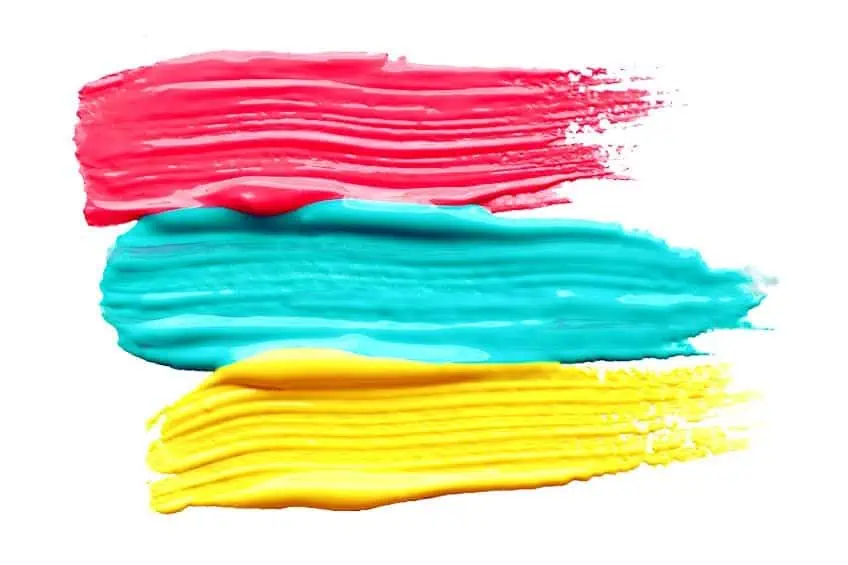
Gloss Acrylic Gel
We have just dealt with the different gel thickening mediums. An excellent product to purchase for this purpose is Liquitex’s Professional Gloss Heavy Gel Medium. Let us now consider the different types of gel thickening mediums, each providing a different finish when mixed with your acrylic paint. The gloss thickening gel for acrylic paint gives more vibrancy to the existing luminosity of your acrylic paint, allowing you to paint thinner strokes producing highlight effects.
The gel not only thickens your paint but also gives it more of a transparent look at the same time.
Matte Acrylic Gel
Acrylic paint tends to produce a glossy finish, so the matte gel thickener converts this finish into a smoother surface that is non-reflective, taking the glare effect away from the acrylic paint. An excellent product for this purpose is Liquitex’s Professional Matte Gel Medium, Clear.
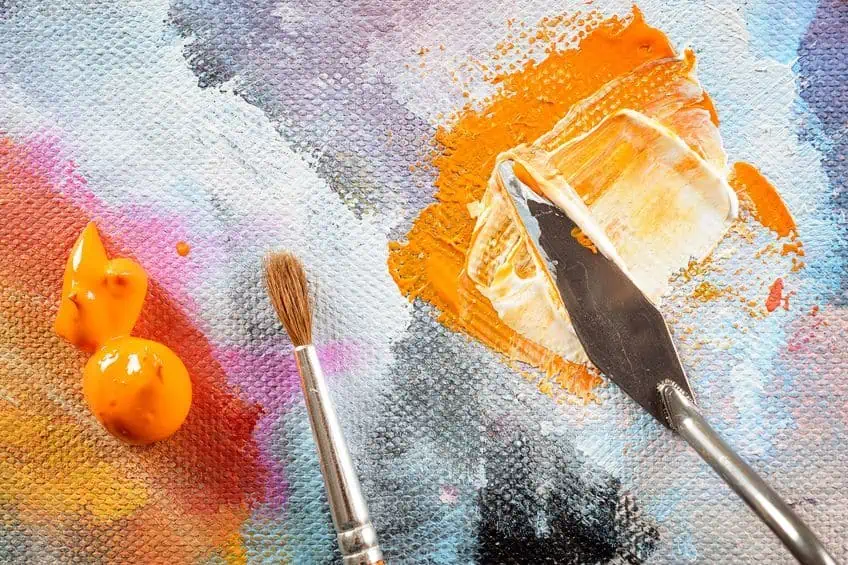
Textured Acrylic Gel
This gel thickener is different from the others as it not only thickens the paint, but it has its very own texture characteristic, incorporating other elements such as sand, glass beads, pumice, fibers, and stucco into the formulation. One excellent product for this purpose is Liquitex’s Professional Effects Medium: Glass Beads.
The main advantage of the textured gel medium is that it will allow you to shape the texture while it is drying. You might even experiment yourself by making your own textured gel by adding some sand or sawdust to your gel giving you different textures.
This thickening gel for acrylic paints is flexible, durable, and very effective in adhering to the canvas. However, some of the textured gels also contain color, and if you choose to use one of them then you might find a slight change in color in your acrylic paint once it has dried. There are two options you can choose when mixing this gel with your paint and each will produce different results.
- First, you can apply the textured gel directly onto your canvas, wait for it to dry, and then apply your acrylic paint over the gel. There should be little or no change to the color of the paint.
- Second, you can mix the textured gel in even proportions with your paint. Once applied, there may be a slight change in the color of your paint when it is dry.
Acrylic Paste Mediums
Another way that you can thicken your acrylic paint is to use some modeling paste that is readily available from any local art store or online. If you are just starting with modeling paste, it is important to understand that the modeling paste can be white, or it can contain some form of ingredient that enriches or brightens the colors of your paint.
The modeling paste can change the original color of your acrylic paint and will also result in giving your painting a three-dimensional effect. However, it needs to be applied using a palette or putty knife. Modeling paste will also allow you to control the outcome of your painting. As it begins to dry, you can mold or shape it into any form or shape you want and then just paint over it.
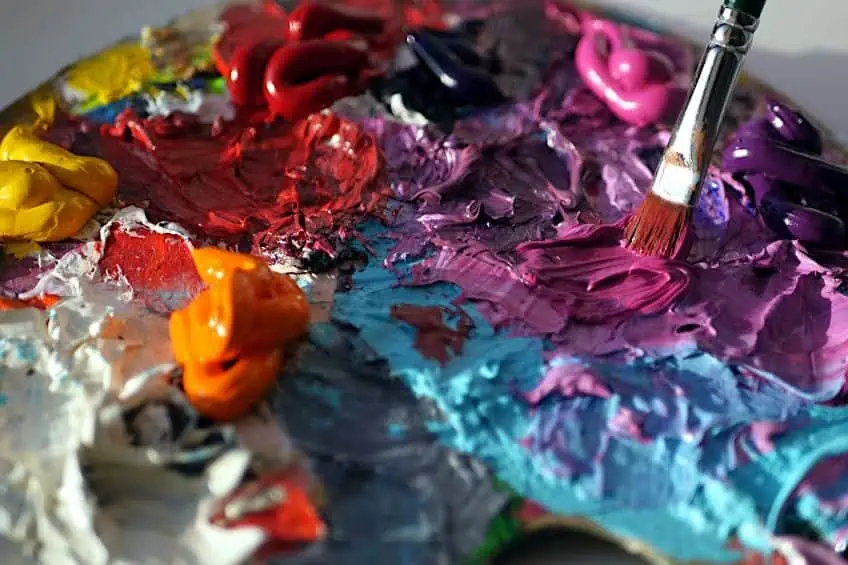
The modeling paste will enrich the beauty of your painting whether it is a finished, luster, or watercolor effect. To obtain a textured effect, you need to mix it with some sand, sawdust, or stucco, depending on what surface you are working on. Whether it is a canvas or even a type of board, the results will always be amazing. An excellent product to purchase for this purpose is the Liquitex Professional Modeling Paste Medium.
When mixing the paste, all you need to do is add a small amount to your acrylic paint, then using a putty or palette knife, mix evenly until you are satisfied with its consistency. Then you can paint on your canvas or whatever surface you choose using your palette or putty knife. Just a short word of caution, the paste will dry an opaque white color so your acrylic paint will end up with a slightly lighter color.
How to Thicken Acrylic Paint Using a Gel or Paste Medium
There are numerous ways to thicken acrylic paint, but if you want your artwork to last or give it as a gift, then you need to use the correct medium to do so. The only medium that will last is a gel or a paste. Let us now guide you through the correct procedure for thickening your paint. The only way for you to thicken your paint and ensure that it will last and look great is to use a thickening medium that is specially designed for use with acrylic paints. The gel or paste mediums will guarantee that the finish and color of your paint are exactly as they should be. You need to check the product label to see if your medium is compatible with acrylic paint.
If you are looking for a textured finish, then you need to purchase a textured paste or gel that has sand or some other ingredient to give it a rough look or texture. Some examples of this type of medium are modeling paste, stucco, resin gel, or sand gel.
Take your tube of paint and squeeze out a small amount onto your palette and make sure you spread out the paint so that the thickening medium can mix with it. Do not be concerned if you feel you have not squeezed out enough paint as you can always add some more later. Now take some of the gel or the paste and add it to your paint. The ratio should be 1:4, meaning one part of gel or paste to four parts of paint. When adding too much gel or paste, it may make your paint unstable.
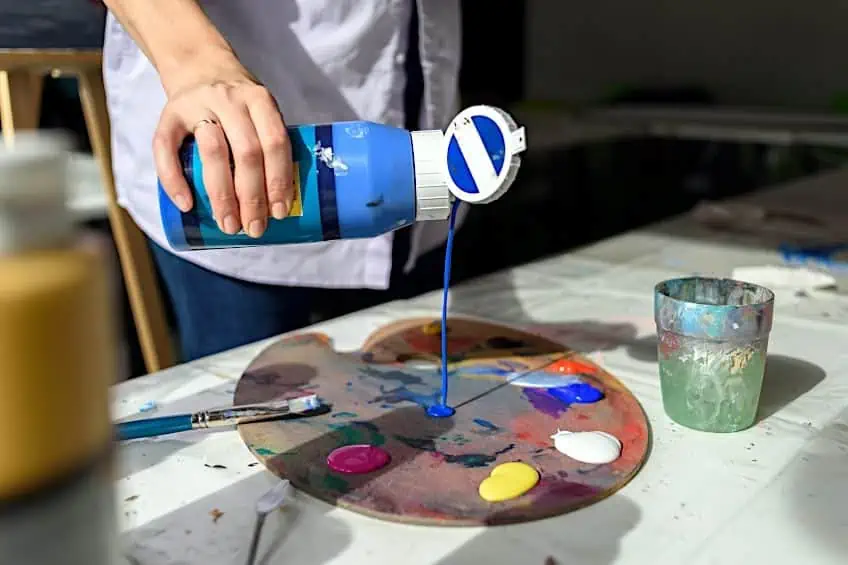
Now you can begin to mix the gel or paste with your paint until you are satisfied with the consistency, and you are ready to paint. You can use a palette knife or even your paintbrush to mix, but a palette knife is preferred if you are mixing textured gel or paste to your paint. Take note that the gel or paste medium will have the effect of increasing the drying time of your paint, so get started right away with painting.
Homemade Acrylic Mediums
Acrylic Gel and paste are the acceptable mediums to use when you want to thicken your acrylic paint, but if you are a beginner and just want to see what happens, then some homemade acrylic mediums are great to experiment with. These mediums are quicker and easier to use and are a lot cheaper, with most of them being ingredients that everyone has in their home.
However, all of them have their limitations, and if you want to create a masterpiece that you want to last for a long time, then these homemade thickeners are not the answer.
Since these mediums are prone to decay over time, and that is not what you want with your painting. You want your painting to last and stand the test of time, which means you need to use the right mediums for thickening your paint. Furthermore, if you need to add some water to your paint after you have thickened with mediums, it will transform into a crumbly paste that has many small lumps. This makes it impossible to perform any sliding brush strokes. You will also observe that there is a lot of uneven distribution of the acrylic paint colors. But if you want to give it a try, let us consider some of these homemade acrylic thickening mediums.
Cornstarch
Cornstarch is a product we all have in our kitchen cupboard, and we use it to thicken gravy or soup. For this reason, it can also be used as an acrylic paint thickener, and all you need is some cornstarch and water. You will need to take two cups of water and add three tablespoons of cornstarch and mix it well. Then you need to transfer this mixture to a saucepan and heat it on the stove at low heat until it boils. Keep on stirring the mixture until it forms a thick paste, then remove it from the stove and allow it to cool. Now your cornstarch paint thickener is ready for you to use.
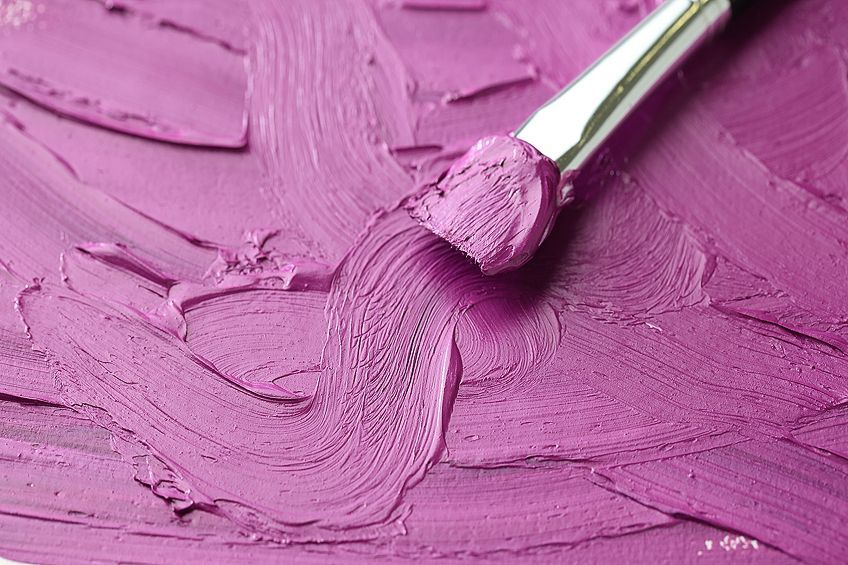
When mixing in your paint, make sure you add the paste a little at a time, mixing it properly each time using a Popsicle stick or a paint stick. Continue to do this until you are happy with the consistency. Your thickened paint is now ready to apply to your canvas or another surface you are painting on. Remember, that the thickened acrylic paint you have created by using cornstarch will only last for a short time and will then start breaking down. So, if you want to have a painting that lasts for a long time, it is better to use the more expensive and effective products like gels and pastes, as discussed above.
Joint Compound
A joint compound is a product you would use to fill up or seal any joint or cracks in your drywall. This product is readily available at any hardware store at a very affordable price. You can also use this to thicken your acrylic paint, but like cornstarch, the longevity of the finished product is not guaranteed, and it tends to crack when applied to paper or canvas. Take a small amount of the joint compound and mix it with your acrylic paint until you are satisfied with the consistency. While mixing, it will feel like you are mixing sand into your paint. The joint compound easily blends with the acrylic paint and dries very quickly to a great finish.
Although the joint compound is light gray, it will slightly lighten the color of your acrylic paint.
Talcum Powder
Take some talcum powder and add water to it and mix well until you are satisfied with the consistency. Then add it to your acrylic paint. The finish you will achieve by using the talcum powder is a semi-matte finish, which will also result in your acrylic paint losing some of its luminosity, so it becomes slightly dull. The paint may also become a little crumbly.

For a better result with the talcum powder, use some Polyvinyl Acetate (PVA) glue. Take one part of PVA glue and mix it with one part of talcum powder, and for a thicker consistency just keep adding more talcum powder until you are satisfied. Now take that mixture and add it to the paint, you are then ready to use.
Flour
Similar to cornstarch, flour is used in the kitchen to thicken soup and gravy and is also used to make Papier Mache. Therefore, many painters wonder if it will also thicken their acrylic paint. Yes, it will be able to thicken your acrylic paint, but it will not last very long and may even begin to flake off after a short time. One advantage of using flour to thicken your paint is that it causes the paint to dry much faster.
However, acrylic paint in itself already dries fast, so this may be more of a disadvantage.
Flour also gives an elastic and springy effect when mixed with water. This is not good when it comes to painting as the paint will become sticky and gooey. You will also find that your paintbrush does not work well with the mixture and your paint will not hold the bristle marks as you would sometimes like. The flour will also give your acrylic paint a very coarse and textured finish, and can also make your paint brittle and will crack after it dries. So, if you intend to keep your painting or give it as a gift, then we do not recommend that you use flour to thicken your acrylic paint.

You can practically use anything to thicken your paint, and some artists have been found using the following items to make acrylic paint thicker and to produce more interesting textures. For example, they are painting a textured beach scene or sandy shore, and the thick textured paint they have created gives the painting life. Some of these “thickeners” include the following.
- Pencil shavings
- Sand
- Ripped tissue paper
- Oats
Acrylic gel and paste mediums are the best products to use for thickening your acrylic paints. This is because the paint medium lets you control the thickness, transparency, and finish of your paint. You can create your textures without the concern of the paint breaking down or falling apart over time.
Frequently Asked Questions
Can You Use Cornstarch to Thicken Your Paint?
Cornstarch can be used as an acrylic paint thickener, but it will not last for a long time. So, if you want to preserve your painting, then cornstarch is not a good idea, rather use a gel or paste paint medium.
How Do You Use Gel Acrylic Medium to Thicken Paint?
You put some paint onto your palette, add some gel and start to mix it using your paintbrush or a palette knife. If you are using a textured gel, a palette knife should be used. Also, remember that the paint will begin to dry faster after you mix in the gel, so you better get started as soon as possible with your painting.
How Do You Use Acrylic Paste Medium to Thicken Paint?
You follow the same process you did for using a gel to thicken your paint but use a palette knife and mix in the paste until you are satisfied with the consistency, and then you are ready to start painting.
How Can You Obtain Thick Textured Acrylic Paint?
If you want a textured finish for your painting, you need to mix the paint with some textured gel that contains some glass beads or sand. When using this mixture, you will have added texture to your finished painting.
Megan is a writer and researcher who graduated from the University of Cape Town with a degree in Social Sciences, specializing in Psychology and Environmental Science. Her passion for knowledge and leaving a positive impact has fueled her current work in conscious and sustainable growth in Southern Africa. Megan’s love of nature has also led her to train as an animal behaviorist. She works part-time training and rehabilitating dogs. Megan is interested in the physical and psychological effects of colors in our environment on our mood and well-being. In addition, she is concerned with how art and creativity have been an integral part of human society. Megan van Schoor has been writing blog posts on the topics of painting, drawing, and color theory for acrylgiessen since 2021.
Learn more about Megan van Schoor and about us.
